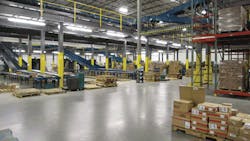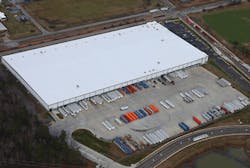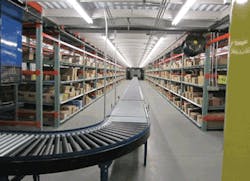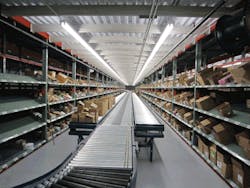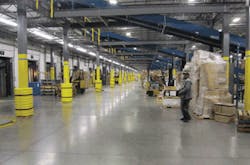Compete: Navy Exchange - "Accelerate Your Logistics"
Members of any branch of the U.S. military will tell you they joined to serve their country. For them, such service is its own reward.
That said, there are logistics professionals in the military whose job it is to offer some of the comforts
Williams' organization works to make sure prices on the consumer goods sold through Navy Exchanges (NEX) are 20-22% below what competitors sell them for. A NEX can range in size and format from a small convenience store to a large department store. Those larger stores carry everything a chain store carries, from watch batteries to 7-ft-tall freezers. Managing a supply chain of such diversity requires a strong network of distribution centers.
The NEXCOM distribution network consists of three U.S. DCs in Chino, Calif. (supporting Asia, Hawaii and the western half of the U.S.); Pensacola, Fla., which supports the uniform program, e-commerce order fulfillment, Cuba and most of NEXCOM's fashion processing; and a new DC in Suffolk, Va., which replaces two older warehouses in serving the mid and upper East Coast as well as Europe, Africa and the Middle East. It's this Suffolk DC which Williams is particularly proud of, not only because it is brand new, but because of the challenges his group overcame to get it up and running.
Built-to-Suit
The Suffolk DC replaces two older facilities based in Norfolk, Va. How the new facility came to be is a story Williams enjoys telling.
"We were in two pre-WWII buildings at the Norfolk Naval base property, one being 200,000 sq ft, and the other maybe 135,000 sq ft," he recalls. "One was a quonset hut a quarter mile long with train tracks running through it. That was actually the bigger half of our northeast DC—far from what you would call efficient. Once we got our merchandise and distribution systems in place, we finally had the data to quantify the redundancy between the two buildings, and that turned into a project with an ROI attached."
When NEXCOM got the OK to bid out the lease on a new building, they were interested to see that one of the bids was for a build-to-suit. That's the bid that won the project.
NEXCOM worked with TranSystems, a site location consultant, to crunch the numbers and come up with the right location and design for a new distribution center to better fit their needs. This was a welcome change from the experience NEXCOM had with its other two DCs which involved moving into existing buildings and figuring out the racking considerations based on that footprint.
"The significant opportunity in being able to design within a build-to-suit is that the operation's design could match the design requirements with very few compromises," explains Norm Saenz, Jr., senior vice president and principal of TranSystems. "The column spacing, clear height, locations of offices, number of dock doors, trailer parking provided, car parking, etc., could all meet what we'd determined would best suit NEXCOM's 10-year requirements."
The big challenge was that the timeframe to move into the building, which would normally have been longer than moving into an existing, empty space, was compressed to meet NEXCOM's required move dates. That meant many overlapping events had to be coordinated. Nevertheless, this project excited Williams.
"We were able to get involved at the very beginning of the project," he said. "This gave us more control over the flow and design. Using our item data and what we thought the future would bring, we were able to specify many different types of racking to maximize efficiency and space. That meant a lot of pushback racking and narrow-aisle high cube."
That design had to turn into a functioning DC within nine months. And although NEXCOM would be leasing this facility for a 15-year term, the agreement gives them two chances to purchase the building from the landlord. The first opportunity comes up in 2014. That gave them an extra incentive to custom-fit this facility to its supply chain.
The Flow of Incoming
The result is a DC that both cross-docks and stores merchandise. It receives advance shipment notices (ASNs) from 620 of its suppliers, which pre-pack the merchandise by store. Those cartons can be placed on conveyors and cross-docked to the appropriate shipping lanes. Those items too big for conveying are cross-docked by lift truck.
Because these items are sourced from trusted vendors, their shipments don't require item receiving other than periodic spot checks during the course of the year. This adds speed to the pipeline, which is particularly important where fashion is concerned.
"One of the lines we sell on the women's side is Macy's private label," Williams explains.
"We get a truck of Macy's at 3,000-5,000 cartons, they throw it on the conveyor, and within two hours it's on its way out of shipping. It's pre-ticketed."
Merchandise destined for storage goes from receiving to a temporary staging area, and that night it is put away in the rack so it's available for picking the next day.
This DC warehouses 6,000-11,000 items and does less-than-full-case picking for smaller stores. Storage includes pushback, narrow aisle high cube, and first-in, first-out racking. There are three picking modules in the DC for full case and partial case handling.
Merchandise is slotted by velocity. Slower moving items end up on the upper levels of a rack while faster movers are at the lower levels.
Demand Fulfillment
The merchandising systems in NEXs use an auto replenishment system that feeds item-level data to the DCs the very next day. The bigger NEXs sell everything from furniture to bottled water, so the DC associates must be skilled at maximizing cube in the trailers and containers that will be delivering the merchandise.
This is a two-shift operation, consisting of one big shift that starts at 5 am then a second shift that comes in four hours later. The role of the second shift is to finish what the first shift was doing and then do the putaway for warehouse products that came in that day so they can be picked first thing next morning.
Once orders are picked and cases packed and palletized, they are shrink wrapped and loaded onto the trailers for the stores and containers for overseas stores and DCs.
Productivity Up, Headcount Down
Suffolk has 162 employees, but by the end of the year that count is expected to go down to 148 through attrition. Although business is increasing, the growing efficiency of this new facility is reducing labor and eliminating duplication from the other facility. The DC's software has also highlighted areas of their workflow that were good candidates for improvement.
NEXCOM further customized the software to accommodate its unique supply chain requirements. For example, while its U.S. DCs support NEXs in the U.S. and abroad, they also support other NEXCOM DCs overseas. The purpose is to ward off any surprise surges of demand due to last-minute deployments.
"Our U.S. DCs do about 70% of our business, but we have to make sure we can forward deploy inventory in case ships come in so those overseas DCs won't have to wait 40 days for supplies," Williams says. "We get affected by things that happen in the world and the movement of our military customers. All of a sudden volume will go up and that will probably mean we'll make changes in our logistics and supply chain to deal with it. That's the opposite of what you'd do if you were trying to use JIT inventory to save money and be more efficient."
Indeed, in the face of such inconsistent demand, NEXCOM's risk of inventory ownership is magnified. It also has to be more careful about managing goods with expiration dates.
Williams admits he and his staff must deal with challenges most retail supply chains don't.
But they thrive on such challenges.
"Every retailer's warehouse is different," he says. "That's one of the beauties of logistics. There are no cookie cutter approaches. The secret is to have the right software and smart enough people who can put in place the most efficient processes for your type of business."
About the Author
Tom Andel
Editor-in-Chief
Tom Andel is an award-winning editorial content creator and manager with more than 35 years of industry experience. His writing spans several industrial disciplines, including power transmission, industrial controls, material handling & logistics, and supply chain management.
